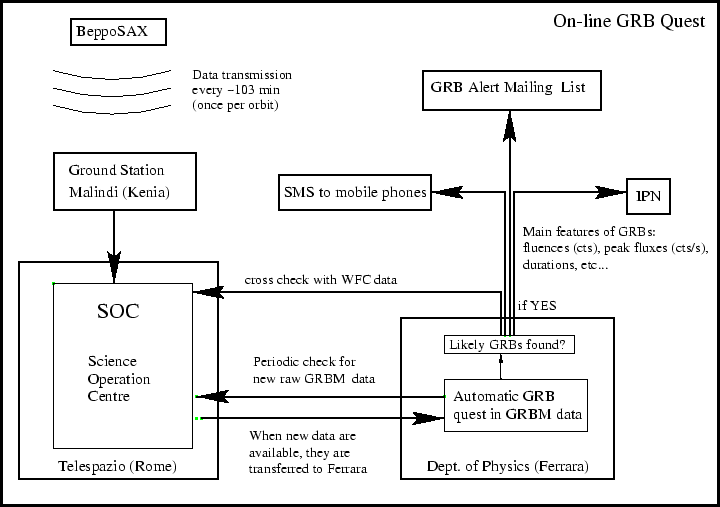



Next: Automatic Alert Mail
Up: The on-line Quest
Previous: The on-line Quest
Contents
The automatic data download and analysis can be summarized in three
steps: 1) the periodic telemetry data download from the BeppoSAX SOC,
one orbit at a time (once every  103 min);
2) GRBM light curves extraction and GRB search: after the download
of the telemetry data from a new orbit to Ferrara, all the relevant scientific
data are extracted; among these, the GRBM light curves of all units in both
energy bands are scanned in order to detect GRB candidate events by applying
the late SWTCs widely described within the previous chapter;
3) alert procedure and data distribution once a GRB candidate has been
discovered: only in this case, the main characteristics of the GRB
candidate are sent within a fixed format mail to a mailing list, including
the SOC, where a cross-check with the WFC data is performed by the duty
scientists in order to detect possible X-ray prompt emission in the WFC data.
When this happens, a prompt localization within a few arcmins becomes
feasible just a few hours after the burst.
103 min);
2) GRBM light curves extraction and GRB search: after the download
of the telemetry data from a new orbit to Ferrara, all the relevant scientific
data are extracted; among these, the GRBM light curves of all units in both
energy bands are scanned in order to detect GRB candidate events by applying
the late SWTCs widely described within the previous chapter;
3) alert procedure and data distribution once a GRB candidate has been
discovered: only in this case, the main characteristics of the GRB
candidate are sent within a fixed format mail to a mailing list, including
the SOC, where a cross-check with the WFC data is performed by the duty
scientists in order to detect possible X-ray prompt emission in the WFC data.
When this happens, a prompt localization within a few arcmins becomes
feasible just a few hours after the burst.
Figure:
Scheme of the on-line quest.
 |
The mailing list also includes people of the GRBM team,
the Ulysses team, for IPN triangulations, when possible, the ASM/XTE team,
the HETE II team (since October 2000) and a machine devoted to
automatic cross-checks with the NEAR data (till February 2001, when
this spacecraft landed on the Eros asteroid).
A scheme describing the overall chain is given in fig. ![[*]](crossref.png) .
.




Next: Automatic Alert Mail
Up: The on-line Quest
Previous: The on-line Quest
Contents
Cristiano Guidorzi
2003-07-31

![[*]](crossref.png) .
.